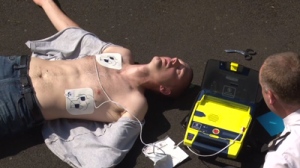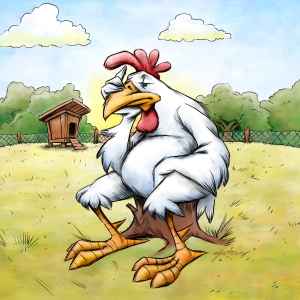
when performing CPR make sure the camera gets your good side.
I don’t know about you, but I’ve spent far too many precious Saturday mornings renewing my CPR certification, kneeled over a motionless, plastic manikin. What does CPR actually accomplish? What purpose does locking lips with a complete stranger and pushing down on their thoracic cavity (like it owes you money) serve anyway? Let’s dive into the physiology of CPR shall we.
What’s the point?
The ultimate purpose of CPR (cardiopulmonary resuscitation) is to re-oxygenate the blood via the lungs and circulate that blood throughout the body by manually compressing the heart. Ideally, the re-oxygenated blood will reach the brain and restore consciousness.
First let’s take another look at the lungs…
Lungs are an elegantly simple respiratory organ (as organs go). From a strictly mechanical point of view, lungs are just big sacks of air. Those sacks have a remarkably air tight seal. In fact, if you perform the CPR breathing technique correctly you should be able to watch the victim’s chest rise with each full breath. That’s why we pinch the victim’s nose, tilt the head back with the chin, and form a seal with our hands around their mouth, then blow. We are filling the lungs with air.
No, I didn’t say oxygen. I said and meant “air.” Oxygen is a pure, gas element but human beings breath a mixture of gases. So when we give the victim breaths we want them to get the oxygen they need but they are also getting the leftover CO2 from our cellular metabolism, and all of the nitrogen, argon, etc. that we took in from the atmosphere. The point I’m making is that providing the victim with adequate oxygen with just your own lung power is a lot of work and pretty inefficient. You’re saving their life but when the EMTs do arrive they will likely provide the victim with 5-10 liters of O2 per minute from a respirator.
What’s with the chest compressions?

pace yourself
I don’t expect everyone to have as much school spirit about the human body as I do, but the heart is so well constructed, so intelligently engineered that even when it stops beating on its own it can still be used to pump blood through the body. Your heart contains chambers and valves that allow blood to flow in one direction with each compression while preventing that volume of blood from flowing backwards. That’s what a pump does. A bicycle pump let’s you exert downward force on the handle to force air directly into the tire without taking air away from the tire when you draw the lever back. So as you exert force on the breast plate blood from the heart will continuously make its way throughout the body with each compression.
So we are delivering two breaths (for an adult) every 30 chest compressions to recharge the blood with oxygen and pump it back throughout the body. We perform chest compressions at a rate of 100/minute or just faster than 1 compression per second because we are simulating a beating heart. If you need to find a rhythm think drum & bass techno or Cuban dance mix not smooth jazz.
A Race against time…
There’s a good reason why breathing is involuntary. Oxygen keeps our cells going. Forget about Kale salads and protein bars. The moment our tissues are cut off from an adequate O2 supply they begin to die (hypoxia). This is why CPR must be instinctive and started the instant no pulse is felt in the victim because the loss of organ function (especially) the brain can happen in minutes.
It won’t work without an AED
 CPR can be a life saver but…not all by itself. There’s a reason the victim’s heart stopped in the first place and you can’t stay on your knees doing compressions forever. Typically there is some form of short circuit in the vital electrical activity of the heart that governs a normal heart beat. In a normal, healthy, jazzercizing heart an electrical signal forming at the top of the heart (at the SA node) contracts the upper atrial chambers, forcing the blood into the lower ventricles (bottom chambers). When that signal makes its way down the heart to the AV node, the ventricles contract, releasing blood into both the body and the lungs. An AED is used to jump-start the heart’s electrical system in an effort to stimulate the nerve impulses of the SA and AV nodes once more. Unless you’re a Jedi knight you just can’t do that with your bare hands.
CPR can be a life saver but…not all by itself. There’s a reason the victim’s heart stopped in the first place and you can’t stay on your knees doing compressions forever. Typically there is some form of short circuit in the vital electrical activity of the heart that governs a normal heart beat. In a normal, healthy, jazzercizing heart an electrical signal forming at the top of the heart (at the SA node) contracts the upper atrial chambers, forcing the blood into the lower ventricles (bottom chambers). When that signal makes its way down the heart to the AV node, the ventricles contract, releasing blood into both the body and the lungs. An AED is used to jump-start the heart’s electrical system in an effort to stimulate the nerve impulses of the SA and AV nodes once more. Unless you’re a Jedi knight you just can’t do that with your bare hands.
Despite what you see in the movies, any victim who receives CPR is not just going to snap out of it and take the rest of the day off. They will 100% of the time need medical attention. In fact, while you’re preparing to do CPR someone should be calling 911.
Hopefully you guys will never have to use it. Let’s be honest, the thought of having to do perform CPR on a real person scares the Hell out of me. Stay curious, stay classy, and never stop learning my friends 🙂


